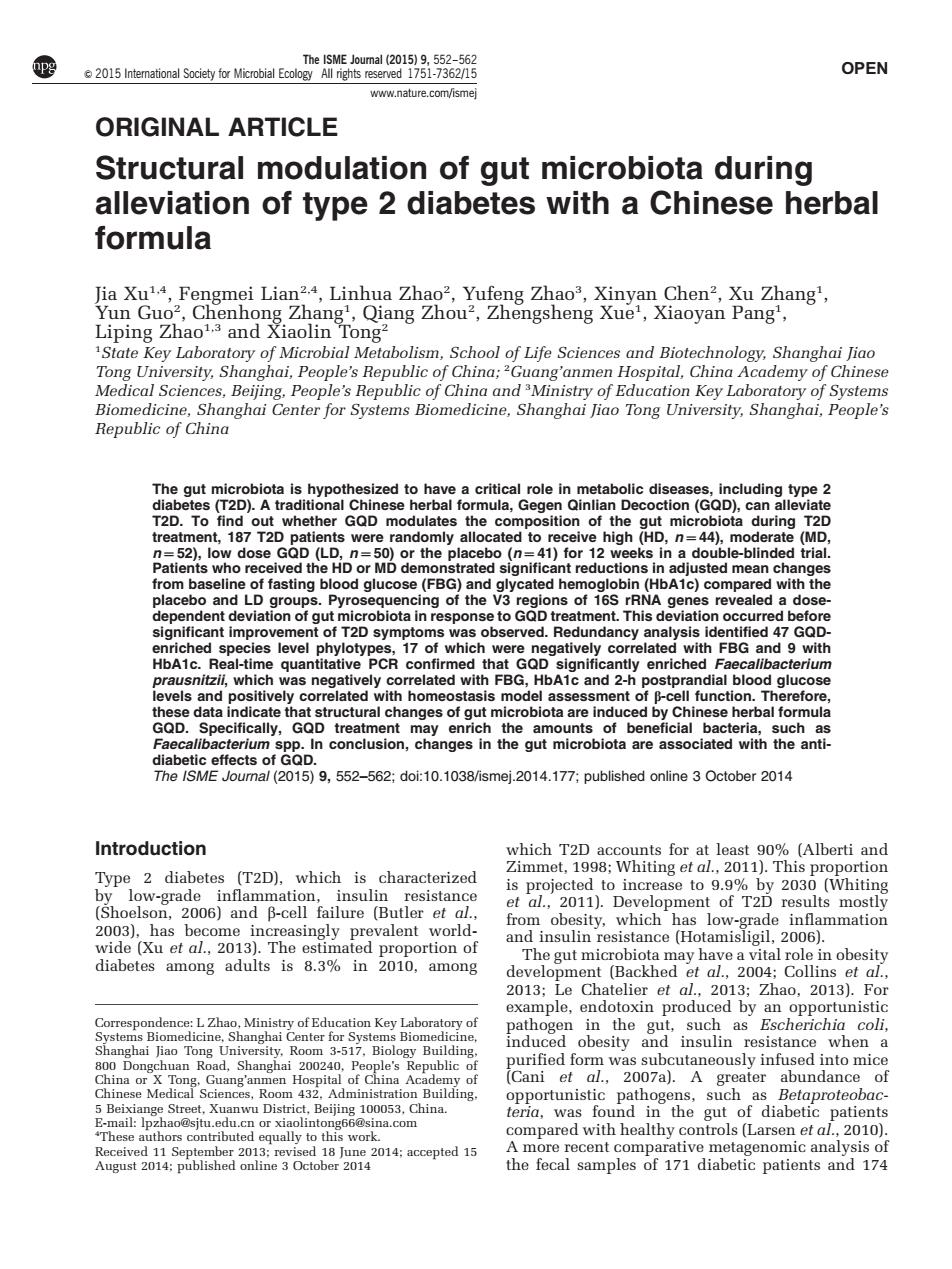正在加载图片...

5 OPEN ORIGINAL ARTICLE Structural modulation of gut microbiota during alleviation of type 2 diabetes with a Chinese herbal formula Jia Xu'4,Fengmei Lian2.4,Linhua Zhao2,Yufeng Zhao2,Xinyan Chen2,Xu Zhang' g',Qiang Zhou2,Zhengsheng Xue',Xiaoyan Pang', Liping Zhao Sciences ond Bntetnloe5hangaoa Medical Sciences.Beijing.People's Republic of China andMinistry of Education Key Laboratory of System Shanghai Center for Systems Biomedicine.Shanghai Jiao Tong University.Shanghai.People's The gut micr robiota is d to hav critical role in metabolic dise igh or the pl n 1)for 12 s in a do of fasting atedherTecl lobin HbA1c)co crobiota inre ment.This occe47b8 ched s BG whic HbAic and 2-hp dial blo a indi OD. es of gut m robiota are inc d by ch herbal formu 88coes6nein9sihthegarme8o8品amaeicemncn The ISME Joumal (2015)9,552-562:doi:10.1038/ismej.2014.177:published online 3 October 2014 Introduction resistance ent world which has an The e 39%a d proportion of insulin res nce(Hotamisade in abes etes among a among 2013: ation Key aboratory o vas and such as Escherichja urified for 200 bcutaneously infused into mic abundance the fecal samples of 171 diabetic patients and 174 OPEN ORIGINAL ARTICLE Structural modulation of gut microbiota during alleviation of type 2 diabetes with a Chinese herbal formula Jia Xu1,4, Fengmei Lian2,4, Linhua Zhao2 , Yufeng Zhao3 , Xinyan Chen2 , Xu Zhang1 , Yun Guo2 , Chenhong Zhang1 , Qiang Zhou2 , Zhengsheng Xue1 , Xiaoyan Pang1 , Liping Zhao1,3 and Xiaolin Tong2 1 State Key Laboratory of Microbial Metabolism, School of Life Sciences and Biotechnology, Shanghai Jiao Tong University, Shanghai, People’s Republic of China; 2 Guang’anmen Hospital, China Academy of Chinese Medical Sciences, Beijing, People’s Republic of China and 3 Ministry of Education Key Laboratory of Systems Biomedicine, Shanghai Center for Systems Biomedicine, Shanghai Jiao Tong University, Shanghai, People’s Republic of China The gut microbiota is hypothesized to have a critical role in metabolic diseases, including type 2 diabetes (T2D). A traditional Chinese herbal formula, Gegen Qinlian Decoction (GQD), can alleviate T2D. To find out whether GQD modulates the composition of the gut microbiota during T2D treatment, 187 T2D patients were randomly allocated to receive high (HD, n ¼ 44), moderate (MD, n ¼ 52), low dose GQD (LD, n ¼ 50) or the placebo (n ¼ 41) for 12 weeks in a double-blinded trial. Patients who received the HD or MD demonstrated significant reductions in adjusted mean changes from baseline of fasting blood glucose (FBG) and glycated hemoglobin (HbA1c) compared with the placebo and LD groups. Pyrosequencing of the V3 regions of 16S rRNA genes revealed a dosedependent deviation of gut microbiota in response to GQD treatment. This deviation occurred before significant improvement of T2D symptoms was observed. Redundancy analysis identified 47 GQDenriched species level phylotypes, 17 of which were negatively correlated with FBG and 9 with HbA1c. Real-time quantitative PCR confirmed that GQD significantly enriched Faecalibacterium prausnitzii, which was negatively correlated with FBG, HbA1c and 2-h postprandial blood glucose levels and positively correlated with homeostasis model assessment of b-cell function. Therefore, these data indicate that structural changes of gut microbiota are induced by Chinese herbal formula GQD. Specifically, GQD treatment may enrich the amounts of beneficial bacteria, such as Faecalibacterium spp. In conclusion, changes in the gut microbiota are associated with the antidiabetic effects of GQD. The ISME Journal (2015) 9, 552–562; doi:10.1038/ismej.2014.177; published online 3 October 2014 Introduction Type 2 diabetes (T2D), which is characterized by low-grade inflammation, insulin resistance (Shoelson, 2006) and b-cell failure (Butler et al., 2003), has become increasingly prevalent worldwide (Xu et al., 2013). The estimated proportion of diabetes among adults is 8.3% in 2010, among which T2D accounts for at least 90% (Alberti and Zimmet, 1998; Whiting et al., 2011). This proportion is projected to increase to 9.9% by 2030 (Whiting et al., 2011). Development of T2D results mostly from obesity, which has low-grade inflammation and insulin resistance (Hotamisligil, 2006). The gut microbiota may have a vital role in obesity development (Backhed et al., 2004; Collins et al., 2013; Le Chatelier et al., 2013; Zhao, 2013). For example, endotoxin produced by an opportunistic pathogen in the gut, such as Escherichia coli, induced obesity and insulin resistance when a purified form was subcutaneously infused into mice (Cani et al., 2007a). A greater abundance of opportunistic pathogens, such as Betaproteobacteria, was found in the gut of diabetic patients compared with healthy controls (Larsen et al., 2010). A more recent comparative metagenomic analysis of the fecal samples of 171 diabetic patients and 174 Correspondence: L Zhao, Ministry of Education Key Laboratory of Systems Biomedicine, Shanghai Center for Systems Biomedicine, Shanghai Jiao Tong University, Room 3-517, Biology Building, 800 Dongchuan Road, Shanghai 200240, People’s Republic of China or X Tong, Guang’anmen Hospital of China Academy of Chinese Medical Sciences, Room 432, Administration Building, 5 Beixiange Street, Xuanwu District, Beijing 100053, China. E-mail: lpzhao@sjtu.edu.cn or xiaolintong66@sina.com 4 These authors contributed equally to this work. Received 11 September 2013; revised 18 June 2014; accepted 15 August 2014; published online 3 October 2014 The ISME Journal (2015) 9, 552–562 & 2015 International Society for Microbial Ecology All rights reserved 1751-7362/15 www.nature.com/ismej